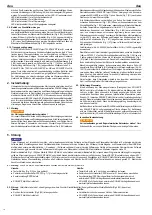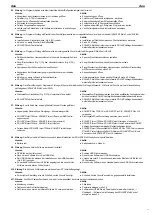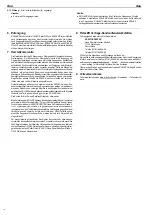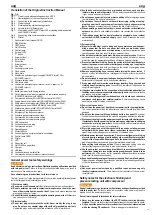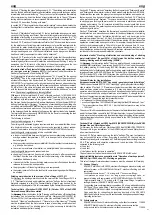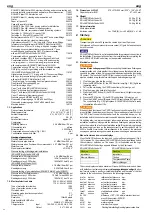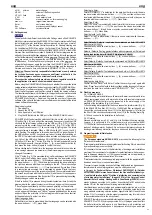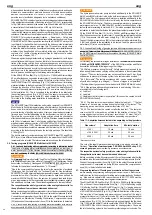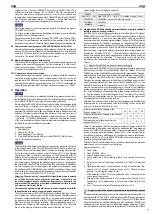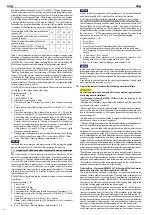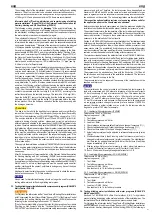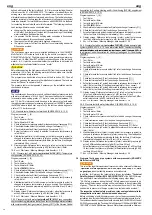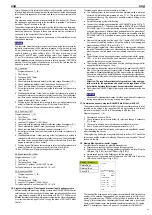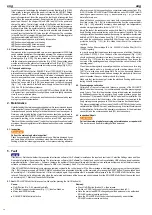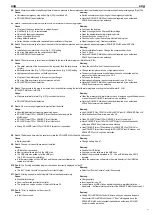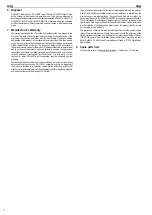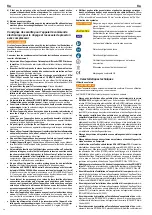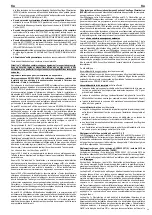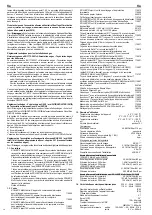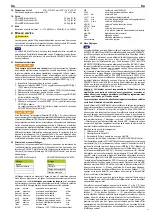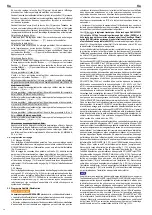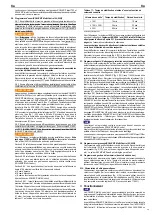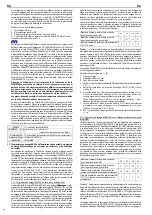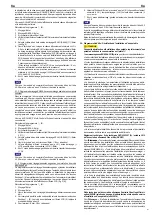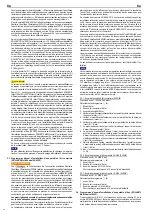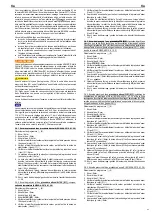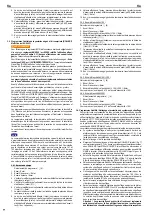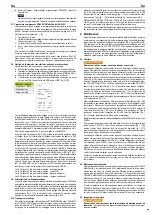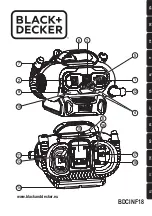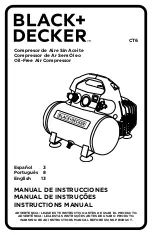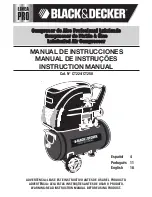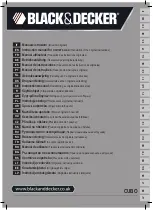
eng eng
Insert the paper roll and charge the battery before using the printer (Fig. 9 (40)).
If the printer is charged without the paper roll inserted, the LED (41) fl ashes
repeatedly 3 times. Push back the paper compartment rail (42) to open the
paper roll compartment. Insert the paper roll so that its end is transported from
below. Close the paper compartment. Keep the button (43) pressed for manual
paper feed. Connect the charger (44) and USB lead (45) to the printer and
charge the printer. To print stored results of the fl ushing and test programs,
plug the USB lead (45) into the USB port (Fig. 2 (33)). After selecting the memory
manager, press Enter, the printer switches on automatically. Select the Display/
Print menu item, select the fi le no. Press Enter to print the data shown on the
screen. Press the the button (43) twice to switch off the pusher. The connection
to the USB line (45) or charger (44) must be disconnected. The following printer
functions are indicated with the LED (41).
LED fl ashes repeatedly once: printer ready for operation.
LED fl ashes repeatedly twice: overheating
LED fl ashes repeatedly 3 times: low paper
LED fl ashes repeatedly 4 times: unsuitable charger
3.9. Operation of compressed air tools
Compressed air tools can be operated up to a max. air requirement of 230 Nl/min
can be operated directly from the compressed air vessel. The air pressure supplied
by the compressed air vessel can be checked on the compressed air vessel
pressure gauge (Fig. 4 (30)). The compressor can be switched off at any time
with the compressor emergency stop button (Fig. 4 (29)). The adjusting wheel
must be raised to set the pressure of compressed air tools (Fig. 4 (31)). The set
pressure can be read at the compressed air tools pressure gauge (Fig. 4 (32)).
3.10. Transport and storage
Drain ROLLER’S Multi-Control, ROLLER’S Inject TW, ROLLER’S Inject H as
well as all hoses completely to avoid damage; store dry at ≥ 5°C. Residue water
from pressure testing with water, fl ushing, disinfection, cleaning and preserva-
tion should be removed with the connecting hose compressor/water connections
(Fig. 8 (38)) after every use. This is connected to the compressed air tools
connection on one side (Fig. 4 (28)) and respectively to the fl ushing supply
(Fig. 1 (14)) or the pressure test with water supply on the other side (Fig. 1
(24)). See 3.9 for the further procedure.
Protect ROLLER’S Plus TW-D Color, ROLLER’S Plus H-R and ROLLER’S Plus
H-K against frost, heat and direct sunlight. Keep containers tightly closed and
store in a cool, well-aired place.
The water connections on the device and the hoses should be sealed by caps
or plugs to prevent contamination.
4. Maintenance
Notwithstanding the maintenance described below, it is recommended to send
in the power tool to an authorised ROLLER contract customer service workshop
for inspection and periodic testing of electrical devices at least once a year. In
Germany, such periodic testing of electrical devices should be performed in
accordance with DIN VDE 0701-0702 and also prescribed for mobile electrical
equipment according to the accident prevention rules DGUV, regulation 3
"Electrical Systems and Equipment". In addition, the respective national safety
provisions, rules and regulations valid for the application site must be considered
and observed.
4.1. Inspection
WARNING
WARNING
Pull out the mains plug before inspection!
Check hoses and seals for damage before every use. Replace damaged hoses
and seals. Keep all the hose connections clean. Remove residue water from
fl ushing, disinfection, cleaning, preservation or from pressure testing with water
after every use with the connecting hose compressor/water connections (Fig.
8 (38)). Flush the ROLLER’S Inject TW disinfection unit or ROLLER’S Inject H
cleaning and preservation unit (Fig. 7), without bottle (Fig. 7 (21)), with fresh
water after every use.
Keep all the hose connections clean. Open both condensation screw plugs
from time to time (Fig. 1 (34)) to drain condensation from the compressed air
tank (Fig. 1 (35)), especially necessary when working at low temperatures;
observe storage temperature for unit of ≥ 5°C (1.3).
Empty the tank of the condensation and particle fi lter (Fig. 4 (46))
Empty the tank of the condensation and particle fi lter
Empty the tank of the condensation and particle fi lter
in the elec-
tronic fl ushing and pressure testing unit with compressor regularly. The fi lter
cartridge must be cleaned and replaced if necessary. On machines manufactured
before April 2018, the protective hood (Fig. 1 (37)) must be removed to empty
and clean the condensation and particle fi lter. Loosen the 6 screws of the
and clean the condensation and particle fi lter. Loosen the 6 screw
and clean the condensation and particle fi lter. Loosen the 6 screw
protective hood (Fig. 1 (37)) for this. Clean the air fi lter of the compressor
regularly.
Change the fi ne fi lter cartridge (Art. No. 043054) of the fi ne fi lter (Art. No.
115609) regularly.
In order to ensure that the date and time remain saved at all times, the button
cell (Lithium CR1220, 3 V) on the back of the operating panel (Fig. 1 (36))
should be changed about every two years. Loosen the 6 screws of the protec-
tive hood (Fig. 1 (37)) to do this, remove the protective hood. Then loosen the
4 screws of the operating panel and change the button cell on the back of the
operating panel.
Clean the machine regularly especially when it has not been in use for a long
time. Clean plastic parts (e.g. housing) only with machine cleaner (Art. No.
140119) or a mild soap and a damp cloth. Do not use household cleaners.
These often contain chemicals which can damage the plastic parts. Never use
petrol, turpentine, thinner or similar products for cleaning.
Make sure that liquids cannot get inside the electronic fl ushing and pressure
testing unit with compressor.
4.2. Pressure gauge calibration
Calibration of the control elements (pressure sensors) of the ROLLER'S
Multi-Control is not necessary. It is recommended to check the pressure gauge
every 2 years. To do this, the pressures shown in the display can be checked
by additionally connecting an accurate, fi nely scaled pressure gauge (see
Accessories 1.2) between ROLLER'S Multi-Control and the installation. You
must make sure here that the pressure of the stress test is not applied to the
fi nely scaled pressure gauge up to 250 mbar, otherwise it will be destroyed.
The pressures displayed on the screen of the ROLLER'S Multi-Control can be
calibrated at the ROLLER Service Center if necessary. A test certifi cate is issued
for the calibration. Calibration of the external pressure gauge for the pressurised
vessel (30) and the compressed air tools (32) is not necessary.
4.3. Inspection / Repair
WARNING
WARNING
Pull out the mains plug before carrying out maintenance or repair work!
This work may only be performed by qualifi ed person
This work may only be performed
This work may only be performed
nel.
5. Fault
NOTICE
NOTICE
If faults occur, fi rst check whether the respective latest version software (Ver. Software) is installed on the input and control unit. Select the Settings menu and then
Device data to display the version software. The latest version software (Ver. Software) for the input and control unit is available by USB stick as a download under
www.albert-roller.de → Downloads → Software. Compare the number of the version software with the latest version software number and install the latest version
software on the input and control unit by means of a USB stick if necessary. See 2.3 for the further procedure.
If the ROLLER’S Multi-Control welcome message remains constant in the control panel or if the Error message is displayed in any program on the control panel
(Fig. 1
(36)), the power supply of ROLLER’S Multi-Control should be interrupted by pulling out the mains plug or pressing the RESET button (2) and switched back
on according to 2.1. Electrical Connection. If Error is displayed again, the procedure must be repeated after pressure in the ROLLER’S Multi-Control has been
relieved. To do this, pull out the mains plug, close the water pipe and remove all the hoses, caps and stoppers from the ROLLER’S Multi-Control, then switch back
on according to 2.1. Electrical Connection of Machine.
5.1. Fault: ROLLER’S Multi-Control does not switch on after pressing the On/Off button (4).
Cause:
Remedy:
● On/Off button (Fig. 2 (4)) pressed too briefl y.
● Press On/Off button for about 2 s, then release.
● PRCD fault current circuit breaker (Fig. 1 (1)) is not switched on.
● Switch on PRCD fault current circuit breaker as described in 2.1..
● Mains lead/PRCD defective.
● Have the mains lead/PRCD changed by qualifi ed personnel or an authorised
ROLLER customer service workshop.
● ROLLER’S Multi-Control defective.
● Have the ROLLER’S Multi-Control checked/repaired by an authorised
ROLLER customer service workshop.
30

